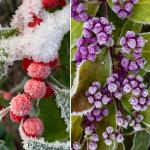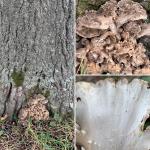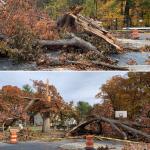UMass Extension's Landscape Message is an educational newsletter intended to inform and guide Massachusetts Green Industry professionals in the management of our collective landscape. Detailed reports from scouts and Extension specialists on growing conditions, pest activity, and cultural practices for the management of woody ornamentals, trees, and turf are regular features. The following issue has been updated to provide timely management information and the latest regional news and environmental data.
Fall Wrap-Up Landscape Education Days
- Dec. 2 - Woody Ornamental Topics (3 pesticide contact hours for categories 29, 36 or Applicators License)
- Dec. 4 - Turf Topics (3 pesticide contact hours for categories 37 or Applicators License)
Join us via GoToWebinar for a review of the challenges and problems of the 2020 season. Attendees can choose to attend either the landscape or turf session, or the entire two-day program. Both will be held as live webinars from 8:30 am to 12:00 pm, with three topics on each day. For more details and registration info, go to https://ag.umass.edu/landscape/upcoming-events.
To read individual sections of the message, click on the section headings below to expand the content:
Scouting Information by Region
Environmental Data
The following data was collected on or about November 4, 2020. Total accumulated growing degree days (GDD) represent the heating units above a 50° F baseline temperature collected via our instruments for the 2020 calendar year. This information is intended for use as a guide for monitoring the developmental stages of pests in your location and planning management strategies accordingly.
|
MA Region/Location |
GDD |
Soil Temp |
Precipitation
|
Time/Date of Readings |
||
|
4-Week Gain |
2020 Total |
Sun |
Shade |
|||
|
CAPE |
199.5 |
2846 |
46 |
45 |
4.37 |
10:00 AM 11/4 |
|
SOUTHEAST |
175.5 |
2949 |
54 |
46 |
6.00 |
2:15 PM 11/4 |
|
NORTH SHORE |
164 |
2852 |
41 |
41 |
4.38 |
9:30 AM 11/4 |
|
EAST |
174 |
3117 |
48 |
45 |
5.34 |
5:00 PM 11/4 |
|
METRO |
134.5 |
2779 |
39 |
38 |
6.04 |
6:45 AM 11/4 |
|
CENTRAL |
142 |
2847.5 |
44 |
39 |
6.25 |
7:00 AM 11/4 |
|
PIONEER VALLEY |
135.5 |
2802.5 |
47 |
46 |
5.94 |
1:00 PM 11/4 |
|
BERKSHIRES |
109.5 |
2504 |
46 |
41 |
3.22 |
9:00 AM 11/4 |
|
AVERAGE |
154 |
2837 |
46 |
42 |
5.19 |
_ |
|
n/a = information not available |
||||||
As of 11/3, most of our state is still suffering some degree of drought: https://droughtmonitor.unl.edu/CurrentMap/StateDroughtMonitor.aspx?MA
Regional Notes
Cape Cod Region (Barnstable)
General Conditions: The average temperature for the period from 9/30 through 11/4 was 55˚F with a high of 75˚F on October 2 and low of 29˚F on October 31. The weather for much of October was warm with temperatures starting to cool off around 10/25 through 11/4. Isolated low-lying frost occurred in the upper Cape on 10/9 and 10/18; however, widespread frost did not occur until October 31. The period was dominated by mostly sunny days except for the 6 days from 10/25 – 30 which were cloudy. Precipitation occurred on several occasions during the past month, with the most coming as a result of the remnants of Zeta followed by a low-pressure system dropping over 2.5 inches from 10/28 - 30. Another precipitation event on 10/17 dropped just over an inch of rain. In total, the period has seen 4.37 inches of precipitation. October alone had 4.23 inches - nearly the same as the precipitation of June, July, August and September combined (4.42 inches). Topsoil moisture is adequate; subsoil moisture is short. Foliage coloration has been decent even with the drought conditions. Maples are mostly defoliated at this time while oaks have just begun to shed leaves.
Pests/Problems: The primary concern during the period would be the drought conditions. Though soil moisture levels have recently improved, the prolonged water stress has impacted plants. Prolonged periods of drought often result in damage to roots, particularly root hairs, the primary root tissue by which plants absorb water. Damage to root hairs reduces the ability for plants to take up water even if soil moisture is adequate. Plants suffering from drought stress before winter often are more susceptible to winter injury – something to keep an eye out for as we head into winter. High populations of Lecanium scale still exist in some areas of the Cape. The scale has migrated from the leaves to woody twigs. Lawns, especially those that were irrigated or renovated in early fall, are growing strong. Some white grub issues have been observed this fall. Winter annual weeds are going to be a problem for lawns damaged by drought conditions.
Southeast Region (Dighton)
General Condition: Tropical lows passing by out at sea brought both moisture and low temperature air from our north. Some of our precipitation gains were in the form of one and a half inches of wet, heavy snow that released slowly as it melted. It was enough to produce flow in vernal (intermittent) streams here at approximately 10 feet above sea level. We haven't seen that since July. We had a light frost, then the snow, wilting tender leaves like grape and Hosta. Lawns have responded well and are green again. Winter weeds have germinated. Chickweed, horseweed, dandelion, Canada thistle and yellow sorrel are stirring in vacant spaces. White ash, sugar maple, red maple, black walnut, shagbark hickory and black cherry have lost their leaves. Norway maple, grey birch, pin oak and Metasequoia are still full although turning color. Winterberry brightens the roadside ditches. The ornamental grasses are in their glory. Nuthatches and chickadees can be seen searching bare branches. House sparrows are taking up winter residence again. Flights of geese can be seen moving from grazing turf to night shelter on nearby waters. I've noticed a few plants in flower among them: Nipponanthemum nipponicum (Montauk daisy) and Sedum 'Autumn Joy'.
Pests/Problems: Heavy snow brought down tree limbs loaded with foliage.
North Shore (Beverly)
General Conditions: Temperatures were quite variable throughout the month of October. The average daily temperature for this period was 53˚F, with the maximum temperature of 79˚F recorded on October 1 and the minimum temperature of 19˚F recorded on October 31. The first frost of the month occurred on October 18 when the thermometer registered 32°F. A total of approximately 4.38 inches of precipitation was received at Long Hill in the month of October. This included 4 inches of snow that fell on October 30th. Although this was much needed precipitation, it was not enough to move the area out of drought. The few plants seen in bloom include: redbud hazel (Disanthus cercidifolius), American witch hazel (Hamamelis virginiana), Daphne (Daphne spp.) and Sheffield pink Chrysanthemum (Dendranthema x grandiflorum). Plants such as hardy orange (Poncirus trifoliata), beautyberry (Callicarpa americana), Wright Viburnum (Viburnum wrightii) and winterberry (Ilex verticillata) are also providing color in the landscape with their fruits.
Pests/Problems: The heavy snow that occurred on October 30th and the strong winds on November 2nd caused some damage to trees in the area. The heavy snow brought down some tree limbs. A dogwood tree at Long Hill split in half due to the snow load. Fall foliage color is also gone because most of the leaves either fell due to the heavy snow or were blown from the trees by strong winds. Deer browsing was observed on young twigs of some crabapples and Hydrangea. Ticks are still active and will remain active anytime the temperature is above freezing. Take precautions to protect yourself when raking leaves by using repellents containing DEET and conducting tick checks after working or even hiking outdoors. Mosquito populations are mostly done for the year.
East Region (Boston)
General Conditions: The first half of October was mild and dry with several daytime highs in the 70’s. On October 13, we received the first of three weather events totaling 5.34 inches of beneficial precipitation. We received an unexpected 4.2 inches of wet heavy snow on October 30 followed by the first cold snap of the season. The growing season ended on October 24 with overnight temperatures dropping to 24˚F. Fall color has varied from early fall color and fallen leaves to green leaves remaining on many plants. Hamamelis virginiana (common witchhazel) is in full bloom, many going unnoticed due to lingering yellow foliage.
Pests/Problems: The 4.2 inches of early snow on October 30 was damaging with many fallen limbs visible throughout the landscape. This was an unusual amount of snow to fall prior to a killing frost. Young trees holding relatively large leaves were especially susceptible suffering structural damage under the weight of the heavy snow. Winter annuals have emerged.
Metro West (Acton)
General Conditions: In October, those in the metro west reporting area experienced a myriad of weather conditions throughout the month including strong winds and gusts, rain, sleet, snow, light and hard frosts and unseasonably warm and cool temperatures. The average monthly precipitation for October is 4.32” and the total measured for the month was 4.69”. The first hard frost was recorded on the morning of October 17th, but not without several previous lighter frosts recorded earlier in the month. A high temperature of 76°F was recorded on the 10/1 and a low temp of 14°F was recorded on the 10/31. Four inches of heavy wet snow covered the landscape on October 30th and it stayed with us until November 1st, disappearing for the most part with the rain. Fruits, pomes, seeds and early fall color are providing some additional interest in the landscape. Seen are the red fruits on Cornus florida (flowering dogwood), C. kousa (Kousa dogwood) and Ilex verticilata (winterberry), a variety of colors and sizes of fruit on Callicarpa dichotoma (beautyberry), Cornus racemosa (gray dogwood), Crataegus spp. (hawthorn), Malus spp. (apple and crabapple), Rosa spp. (rose), Sorbus spp. (mountain ash) and Viburnum spp., and seed heads on ornamental grasses, seed pods on Catalpa sp., and nuts on Carya spp. (hickory), Heptacodium miconioides (seven-son flower), Juglans spp. (walnut) and Quercus spp. (oak).
Pests/Problems: The United States Drought Monitor was updated on November 3 and currently shows that this reporting area is experiencing a moderate drought (see link below environmental data table). With the recent rain and snow events, let’s hope that the status changes and continues to do so. The heavy wet snow and recent strong wind gusts are responsible for a great deal of woody and leaf debris on the ground. Euonymus alatus (burning bush) is easy to detect now that it is in full color and one can see how it got its common name and how invasive it is. Another invasive plant displaying fall color and easy to detect as it climbs high into the canopies of host trees is Celastrus orbiculatus (Oriental bittersweet).
Central Region (Boylston)
General Conditions: What a beautiful end to the gardening season! Autumn color across the region was tremendous this year, owing in part to mild temperatures during the month of October. Our first frosts came early, in late September, but October brought relatively mild weather and few frosts until quite late in the month, allowing gardeners to keep annuals and vegetables going longer than normal. Late season perennials and flowering shrubs lasted well throughout the month, making this one of the more colorful Octobers in recent memory. 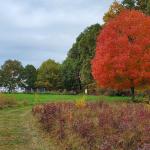 Temperatures touched the mid-70’s as late as October 22, before crashing down to 17˚F to end the month. In addition to large differences in temperature, October brought both a derecho and a plowable snow event. The derecho featured 60-mph wind gusts that lead to widespread power outages and downed trees across a very wide area of the northeast. The October snowstorm dropped 4 inches (or more) in many places across the region. Fortunately, this early snowfall melted within a day or two after falling.
Temperatures touched the mid-70’s as late as October 22, before crashing down to 17˚F to end the month. In addition to large differences in temperature, October brought both a derecho and a plowable snow event. The derecho featured 60-mph wind gusts that lead to widespread power outages and downed trees across a very wide area of the northeast. The October snowstorm dropped 4 inches (or more) in many places across the region. Fortunately, this early snowfall melted within a day or two after falling.
Pests/Problems: In spite of a wetter than normal October, with more than 6 inches of precipitation, the region remains in moderate drought status as of the U.S. Drought Monitor report on November 3 (see link below environmental data table).
Pioneer Valley Region (Easthampton)
General Conditions: We’ve reached the penultimate edition of the Landscape Message as the 2020 season winds down in the Pioneer Valley. After a summer and early fall dominated by the heat and intensifying drought conditions, we received significant rainfall during October and the beginning of November, with nearly 6” of total accumulation. Three rain events had accumulations >1”, occurring on 10/12–13, 10/16–17 and 10/29–30. Several other storms produced minor to moderate rainfall amounts and the last third of October was very cloudy with only one day of full sun (10/31). As a result, soil moisture is high right now but the rain was likely too late for many deciduous trees and shrubs that entered dormancy suffering from drought stress. The entire tri-county area remains in abnormally dry to drought classifications, according to the U.S. Drought Monitor (see link below environmental data table). The region experienced a hard freeze on the morning of 10/18, which may have been the first for some locations that dodged these temperatures in late September. As the month came to a close, we also got a serious taste of winter, with a dusting to several inches of snow and low temperatures near and below 20°F on 10/30 and 10/31. Freezing nighttime temperatures continued through the start of November and highs barely climbed out of the 30s on 11/2. But at the time of writing, the long-term forecast calls for a warm-up, with highs settling into the mid-60s and lows in the mid-40s.
Now, about that derecho on 10/7. To start, the region experienced mild temperatures in the upper 60s and surprisingly high humidity during the first week of October. This humid, high pressure set the stage for severe thunderstorms as a low pressure system tracked southeast from Canada. After some light rain earlier in the day, this powerful band of storms (formally classified as a derecho by the NWS Storm Prediction Center) pummeled the valley in the early evening hours with hurricane-force winds. A derecho is defined as a widespread band of fast-moving, severe thunderstorms that travel at least 240 miles and move at a speed of approximately 60 mph. However, wind gusts can be much stronger, and maximum gusts of 88 mph (Mount Tom, Easthampton) and 74 mph (Barnes Airport, Westfield) proved that. Overall, the storm traveled roughly 320 miles with most of the damage occurring in New York and Massachusetts. The peak wind gusts lasted only a few minutes, but tens of thousands lost power. Numerous trees across the Commonwealth lost large limbs, were split in half, uprooted or suffered stem failure at the base. Several of these trees had internal decay, with the strong winds exposing the structural weakness. Personally, I can’t remember the last time I witnessed an October thunderstorm, especially one with such roiling lightning and deeply resonate thunder. The immediate aftermath revealed tremendous tree damage, especially in localized pockets, with considerable property damage. Clean-up for the storm is still taking place. The fall foliage was indeed excellent this year and peak color seemed to persist for longer than usual. Red maples were the star of the show in the valley, with many trees displaying vibrant red foliage. For trees that were still holding their foliage, the end of October freeze and strong winds, that started during the evening of 11/1 and persisted into 11/2, stripped canopies bare. The rain and cooling temperatures in October were excellent for turfgrasses, which have responded well after browning out in the heat of the summer. A return to mild temperatures will allow for some additional clean up in the landscape, which was slowed by the snow, rain and freezing conditions.
Pests/Problems: Pest and pathogen activity has all but ceased at this time. The cool weather this fall allowed spruce spider mites (Oligonychus ununguis) to resume feeding and additional damage has been observed on trees with established infestations. Fall clean up can help to remove overwintering inoculum for certain foliar disease pathogens, such as Venturia inaequalis, the cause of apple scab. Hen of the woods, Grifola frondosa, can still be found fruiting near landscape trees. Several large clusters were present in the Durfee tree garden on the UMass campus, growing from the decaying roots of a deceased, but formerly massive sweet gum. The tree has been dead and gone for almost a decade and a Japanese elm, planted in honor of Professor Gordon King, now occupies the space. While dead stems and branches can be pruned at any time, now is generally not the best time for pruning live branches. Dormant winter pruning or early spring pruning can be more optimal for certain trees. However, now is a good time to apply deer and rabbit repellents on susceptible plants to discourage winter browsing. Applying when temperatures are below freezing is not recommended since contact freeze injury can take place on the foliage.
Berkshire Region (Great Barrington)
General Conditions: Though not a particularly wet month, October did make up a little ground with respect to rainfall deficit for the year. With most of the precipitation falling during the last week of the month, in the form of rain and a little bit of snow, the rainfall deficit for the year is now 7.19 inches as measured at Pittsfield Airport. Year to date rainfall is 31.74 inches while the normal YTD is 38.93. With the recent precipitation, soils are now quite moist and in good condition for fall planting of woody plants and herbaceous plants. To prevent frost heaving recent plantings, be sure to apply mulch around them. The main weather event of the past scouting period occurred on October 7th when a squall line with fierce winds swept through the region. Wind gusts to 75 mph were recorded at a weather station Pittsfield. Damage was wide spread with numerous trees uprooted, in turn causing damage to buildings and long power outages which lasted in some cases for several days. One storm related death occurred in Berkshire County when a tree fell on an individual. Other than that particular storm, October was relatively mild over the first 3 weeks with a high temperature reading of 76˚F on Oct. 10 in North Adams and on Oct. 22 in Richmond. A high of 75˚F occurred in Pittsfield on Oct.22. Temperatures then dropped dramatically over the last week of October with lows at all 3 reporting stations occurring on Oct. 31: 23˚F in North Adams, 20˚F in Pittsfield, and 17˚F in Richmond. A rebound to mild temperatures is in the offing for early November. The hard freezes have brought the growing season to an end, though turfgrass is showing some growth.
Pests/Problems: Other than house invading critters such as Western conifer seed bug, multicolored Asian lady beetle, boxelder bug, and stink bugs, pest issues have been just about non-existent. With this being a time of considerable clean-up activities in the landscape, it is wise to take all precautions to avoid tick bites. Application of tick repellents is wise. With leaf drop and hardening of woody plants in the natural landscape, deer have frequently turned their attention to foraging on the more tender plants in managed landscapes. Frequent applications of deer repellents may save valuable plant materials. Please read and follow product label instructions when applying repellents.
Regional Scouting Credits
- CAPE COD REGION - Russell Norton, Horticulture and Agriculture Educator with Cape Cod Cooperative Extension, reporting from Barnstable.
- SOUTHEAST REGION - Brian McMahon, Arborist, reporting from the Dighton area.
- NORTH SHORE REGION - Geoffrey Njue, Green Industry Specialist, UMass Extension, reporting from the Long Hill Reservation, Beverly.
- EAST REGION - Kit Ganshaw & Sue Pfeiffer, Horticulturists reporting from the Boston area.
- METRO WEST REGION – Julie Coop, Forester, Massachusetts Department of Conservation & Recreation, reporting from Acton.
- CENTRAL REGION - Mark Richardson, Director of Horticulture reporting from Tower Hill Botanic Garden, Boylston.
- PIONEER VALLEY REGION - Nick Brazee, Plant Pathologist, UMass Extension Plant Diagnostic Lab, temporarily reporting from Easthampton.
- BERKSHIRE REGION - Ron Kujawski, Horticultural Consultant, reporting from Great Barrington.
Woody Ornamentals
Diseases
Recent pests and pathogens of interest seen in the UMass Extension Plant Diagnostic Lab https://ag.umass.edu/services/plant-diagnostics-laboratory:

 Canopy dieback in a mature (~75-year-old) red oak (Quercus rubra) caused by Armillaria (Armillaria root and butt rot) and Coryneum (Coryneum stem canker). Tree resides in a residential landscape with a mixture of sun and shade on the edge of a forest. Decay in the lower trunk has been visible for many years, but appears to have significantly expanded recently. Additionally, the tree developed canopy dieback this season that was not present in the past. Armillaria is a ubiquitous and slow-growing pathogen that often attacks the heartwood at the base of deciduous hardwood trunks. Coryneum is a known stem and branch pathogen of oaks but seems to be more common in southern states. Photos show the fruiting bodies (acervuli) rupturing through the stem bark and the large, distoseptate conidia that emerge.
Canopy dieback in a mature (~75-year-old) red oak (Quercus rubra) caused by Armillaria (Armillaria root and butt rot) and Coryneum (Coryneum stem canker). Tree resides in a residential landscape with a mixture of sun and shade on the edge of a forest. Decay in the lower trunk has been visible for many years, but appears to have significantly expanded recently. Additionally, the tree developed canopy dieback this season that was not present in the past. Armillaria is a ubiquitous and slow-growing pathogen that often attacks the heartwood at the base of deciduous hardwood trunks. Coryneum is a known stem and branch pathogen of oaks but seems to be more common in southern states. Photos show the fruiting bodies (acervuli) rupturing through the stem bark and the large, distoseptate conidia that emerge.
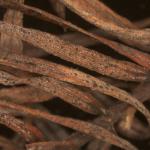
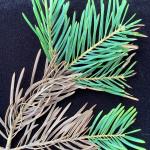 Delphinella shoot blight, caused by Delphinella abietis, on white fir (Abies concolor). Young trees (<five-years-old) at a Christmas tree farm with full sun exposure and no supplemental irrigation. Trees have been treated previously for infestation by the elongate hemlock scale. Drought symptoms were exhibited by some trees but others had blighted shoots and needles at the branch tips. The affected shoots and stems were brown to blackened and curled with numerous black-colored fruiting bodies present (see photo). Fruiting bodies mature in late summer to fall but do not release spores until the following spring. This timing of spore release coincides with the flushing of new growth, which is highly susceptible to infection. Delphinella shoot blight can be a serious pathogen of true firs at Christmas tree farms but the disease is not often encountered in southern New England. Some shoots had older needles blighted by Rhizosphaera (third photo).
Delphinella shoot blight, caused by Delphinella abietis, on white fir (Abies concolor). Young trees (<five-years-old) at a Christmas tree farm with full sun exposure and no supplemental irrigation. Trees have been treated previously for infestation by the elongate hemlock scale. Drought symptoms were exhibited by some trees but others had blighted shoots and needles at the branch tips. The affected shoots and stems were brown to blackened and curled with numerous black-colored fruiting bodies present (see photo). Fruiting bodies mature in late summer to fall but do not release spores until the following spring. This timing of spore release coincides with the flushing of new growth, which is highly susceptible to infection. Delphinella shoot blight can be a serious pathogen of true firs at Christmas tree farms but the disease is not often encountered in southern New England. Some shoots had older needles blighted by Rhizosphaera (third photo).- Needle browning and canopy dieback of mugo pine (Pinus mugo ssp. mugo) due to stem cankering and needle blight caused by Diplodia sapinea (Diplodia shoot and needle blight) and Dothistroma septosporum (Dothistroma needle blight). Tree is over 70-years-old and resides in an arboretum on rocky outcrop with partial shade. For several years, needle browning and thinning of the canopy has been noted. The damage is more apparent on the NW side of the plant, which is likely where shade and moisture are more abundant. Dothistroma is not especially common on pines in the region but is capable of causing significant injury, especially in conjunction with Diplodia and environmental stresses, such as drought.
- Decline and death of inkberry (Ilex glabra), due to transplant shock and stem cankering by Botryosphaeria. Approximately 50 Ilex were planted at the site in 2019 and roughly a third suffered serious winter burn and were replaced this past August. This particular plant, one of the replacements, shed all its leaves and subsequently died shortly after transplanting. Botryosphaeria was abundant on the submitted stem tissue and is common on this host in landscape settings. The site is described as having full sun with well-drained, sandy soils and drip irrigation.
- Rose mosaic virus on a hybrid rose cultivar (Rosa sp.). Mature plants, estimated at >15-years-old, planted in a foundation garden and allowed to climb up the side of a house. The plants receive partial sun, daily irrigation and are pruned often. Symptoms of the infection included yellow mottling (mosaic) and chlorotic lines that resemble the outline of an oak leaf (a distinct symptom of some viral infections of the foliage). Rose mosaic virus is found worldwide wherever roses are grown. Transmission is often through infected rootstock or scion tissue but it can also spread via pollen. Interestingly, the disease has minimal effect on flowering, but infected plants tend to be less vigorous.
- Leaf shedding and canopy dieback of edging boxwood (Buxus sempervirens ‘Suffruticosa’) and Green Velvet boxwood (Buxus ‘Green Velvet’) caused by Calonectria pseudonaviculata (boxwood blight). The site with the edging boxwoods has approximately 70 total plants, with an average age of 20-years-old (some older and some younger). Symptoms of the disease have been observed since 2018, but was misdiagnosed as Phytophthora root rot and subsequent management has failed to slow its spread. Drainage is generally poor and soils are somewhat compacted but the plants are exposed to full sun. Plants at the site with the Green Velvet boxwoods are roughly ten-years-old and were planted seven years ago. This west-facing hedge has performed well until this year, when symptoms appeared in mid-summer. In both cases, a rapid defoliation was noted, which is characteristic of boxwood blight.
Report by Nick Brazee, Plant Pathologist, UMass Extension Plant Diagnostic Lab, UMass Amherst.
Insects
Did you miss the live broadcasts of UMass Extension’s Invasive Insect Webinar Series? No problem! View the archived recordings of all seven webinars here:
https://ag.umass.edu/landscape/education-events/invasive-insect-webinars
Interested in learning more about insect identification and life cycles? Only have 3 minutes or less? Check out InsectXaminer! https://ag.umass.edu/landscape/education-events/insectxaminer
Insects and Other Arthropods of Public Health Concern:
- Deer Tick/Blacklegged Tick: Check out the archived FREE TickTalk with TickReport webinars available here:https://ag.umass.edu/landscape/education-events/ticktalk-with-tickreport-webinars . Previous webinars including information about deer ticks and associated diseases, ticks and personal protection, and updates from the Laboratory of Medical Zoology are archived at the link above.
The next live webinar will be held at Noon on November 18, 2020 – Babesiosis - Speaker: Dr. Sam R. Telford III, Professor, Cummings School of Veterinary Medicine at Tufts University
Dr. Telford III joins Dr. Rich on the TickTalk webinar to discuss the second most commonly reported tick-borne disease in North America (after Lyme disease). Babesiosis is a malaria-like illness transmitted by the same ticks as Lyme. Dr. Telford is recognized as a global authority on this disease. Register at: https://attendee.gotowebinar.com/register/3144222128403757825
From October until roughly May, as long as daytime temperatures remain above freezing, adult male and female deer ticks (Ixodes scapularis) can be active, even in the winter. It is important to protect yourself against ticks and be especially vigilant for tiny, difficult to see nymphs. For images of all deer tick life stages, along with an outline of the diseases they carry, visit: http://www.tickencounter.org/tick_identification/deer_tick .
Anyone working in the yard and garden should be aware that there is the potential to encounter deer ticks. The deer tick or blacklegged tick can transmit Lyme disease, human babesiosis, human anaplasmosis, and other diseases. Preventative activities, such as daily tick checks, wearing appropriate clothing, and permethrin treatments for clothing (according to label instructions) can aid in reducing the risk that a tick will become attached to your body. If a tick cannot attach and feed, it will not transmit disease. For more information about personal protective measures, visit: http://www.tickencounter.org/prevention/protect_yourself .
Have you just removed an attached tick from yourself or a loved one with a pair of tweezers? If so, consider sending the tick to the UMass Laboratory of Medical Zoology to be tested for disease causing pathogens. To submit a tick to be tested, visit: https://www.tickreport.com/ and click on the blue “Order a TickReport” button. Results are typically available within 3 business days, or less. By the time you make an appointment with your physician following the tick attachment, you may have the results back from TickReport to bring to your physician to aid in a conversation about risk.
The UMass Laboratory of Medical Zoology does not give medical advice, nor are the results of their tests diagnostic of human disease. Transmission of a pathogen from the tick to you is dependent upon how long the tick had been feeding, and each pathogen has its own transmission time. TickReport is an excellent measure of exposure risk for the tick (or ticks) that you send in to be tested. Feel free to print out and share your TickReport with your healthcare provider.
Woody ornamental insect and non-insect arthropod pests to consider, a selected few:
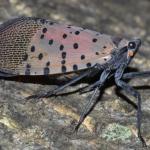


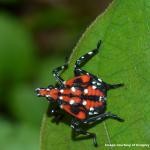 Spotted Lanternfly: (Lycorma delicatula, SLF) is not known to be established in Massachusetts landscapes at this time. However, due to the great ability of this insect to hitchhike using human-aided movement, it is important that we remain vigilant in Massachusetts and report any suspicious findings. Spotted lanternfly reports can be sent here:https://massnrc.org/pests/slfreport.aspx
Spotted Lanternfly: (Lycorma delicatula, SLF) is not known to be established in Massachusetts landscapes at this time. However, due to the great ability of this insect to hitchhike using human-aided movement, it is important that we remain vigilant in Massachusetts and report any suspicious findings. Spotted lanternfly reports can be sent here:https://massnrc.org/pests/slfreport.aspx
On September 25, 2020 the Massachusetts Department of Agricultural Resources (MDAR) urged Massachusetts residents to report signs of the invasive spotted lanternfly (Lycorma delicatula). They announced the finding of two dead specimens of SLF in Massachusetts communities, and are urging residents to report any sign of the invasive pest. The specimens were recovered in the towns of Milford and Norwood, and were brought into Massachusetts on materials shipped from Pennsylvania counties currently under a spotted lanternfly quarantine. Additionally, according to the September 25, 2020 press release, MDAR was recently notified that nursery stock with spotted lanternfly egg masses and adults may have been unintentionally imported and planted in several parts of Massachusetts.
MDAR is urging anyone who has received goods or materials, such as plants, landscaping materials, or outdoor furniture, from a state with a known SLF infestation to carefully check the materials, including any packaging, for signs of spotted lanternfly. Currently, there are known introductions of SLF in Connecticut, Delaware, Maryland, New Jersey, New York, Pennsylvania, Virginia, and West Virginia. For more information about this most recent press release, please visit:https://www.mass.gov/news/state-agricultural-officials-urge-residents-to-report-signs-of-invasive-spotted-lanternfly .
Because no live lanternflies have, as of this press release, been found in Massachusetts, there is currently no evidence that SLF has become established in the Commonwealth. As a precaution, MDAR has planned surveys in the areas where the insects were found, to confirm that no live populations are present. While a dead lanternfly was previously found in the Boston area, in December of 2018, repeated surveys have found no further signs of SLF in that part of the state.
For a map of known, established populations of SLF as well as detections outside of these areas where individual finds of spotted lanternfly have occurred (but no infestations are present), visit: https://nysipm.cornell.edu/environment/invasive-species-exotic-pests/spotted-lanternfly/ This map depicts an individual detection of spotted lanternfly at a private residence in Boston, MA that was reported by the MA Department of Agricultural Resources on February 21, 2019. More information about this detection in Boston, where no established infestation was found, is provided here: https://www.mass.gov/news/state-agricultural-officials-urge-residents-to-check-plants-for-spotted-lanternfly
This insect is a member of the Order Hemiptera (true bugs, cicadas, hoppers, aphids, and others) and the Family Fulgoridae, also known as planthoppers. The spotted lanternfly is a non-native species first detected in the United States in Berks County, Pennsylvania and confirmed on September 22, 2014.
The spotted lanternfly is considered native to China, India, and Vietnam. It has been introduced as a non-native insect to South Korea and Japan, prior to its detection in the United States. In South Korea, it is considered invasive and a pest of grapes and peaches. The spotted lanternfly has been reported feeding on over 103 species of plants, according to new research (Barringer and Ciafré, 2020) and when including not only plants on which the insect feeds, but those that it will lay egg masses on, this number rises to 172. This includes, but is not limited to, the following: tree of heaven (Ailanthus altissima) (preferred host), apple (Malus spp.), plum, cherry, peach, apricot (Prunus spp.), grape (Vitis spp.), pine (Pinus spp.), pignut hickory (Carya glabra), sassafras (Sassafras albidum), serviceberry (Amelanchier spp.), slippery elm (Ulmus rubra), tulip poplar (Liriodendron tulipifera), white ash (Fraxinus americana), willow (Salix spp.), American beech (Fagus grandifolia), American linden (Tilia americana), American sycamore (Platanus occidentalis), big-toothed aspen (Populus grandidentata), black birch (Betula lenta), black cherry (Prunus serotina), black gum (Nyssa sylvatica), black walnut (Juglans nigra), dogwood (Cornus spp.), Japanese snowbell (Styrax japonicus), maple (Acer spp.), oak (Quercus spp.), and paper birch (Betula papyrifera).
The adults and immatures of this species damage host plants by feeding on sap from stems, leaves, and the trunks of trees. In the springtime in Pennsylvania (late April - mid-May) nymphs (immatures) are found on smaller plants and vines and new growth of trees and shrubs. Third and fourth instar nymphs migrate to the tree of heaven and are observed feeding on trunks and branches. Trees may be found with sap weeping from the wounds caused by the insect’s feeding. The sugary secretions (excrement) created by this insect may coat the host plant, later leading to the growth of sooty mold. Insects such as wasps, hornets, bees, and ants may also be attracted to the sugary waste created by the lanternflies, or sap weeping from open wounds in the host plant. Host plants have been described as giving off a fermented odor when this insect is present.
Adults are present by the middle of July in Pennsylvania and begin laying eggs by late September and continue laying eggs through late November and even early December in that state. Adults may be found on the trunks of trees such as the tree of heaven or other host plants growing in close proximity to them. Egg masses of this insect are gray in color and look similar in some ways to gypsy moth egg masses.
Host plants, bricks, stone, lawn furniture, recreational vehicles, and other smooth surfaces can be inspected for egg masses. Egg masses laid on outdoor residential items such as those listed above may pose the greatest threat for spreading this insect via human aided movement.
For more information about the spotted lanternfly, visit this fact sheet: https://ag.umass.edu/landscape/fact-sheets/spotted-lanternfly .

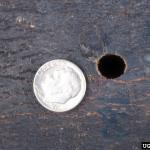
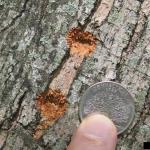 Asian Longhorned Beetle: (Anoplophora glabripennis, ALB) is a serious invasive insect that was first detected in Massachusetts in August of 2008. ALB was detected for the first time in South Carolina in 2020. Asian longhorned beetle eradication programs currently exist in Massachusetts, New York, and Ohio. A homeowner is responsible for finding, reporting, and making officials aware of the infestation in South Carolina. Great job!
Asian Longhorned Beetle: (Anoplophora glabripennis, ALB) is a serious invasive insect that was first detected in Massachusetts in August of 2008. ALB was detected for the first time in South Carolina in 2020. Asian longhorned beetle eradication programs currently exist in Massachusetts, New York, and Ohio. A homeowner is responsible for finding, reporting, and making officials aware of the infestation in South Carolina. Great job!
The U.S. Department of Agriculture’s (USDA) Animal and Plant Health Inspection Service (APHIS) and the Clemson University’s Department of Plant Industry (DPI) are inspecting trees in Hollywood, South Carolina following the detection and identification of the Asian longhorned beetle (ALB).
On May 29, a homeowner in Hollywood, South Carolina contacted DPI to report they found a dead beetle on their property and suspected it was ALB. A DPI employee collected the insect the same day and conducted a preliminary survey of the trees on the property. Clemson’s Plant and Pest Diagnostic Clinic provided an initial identification of ALB, and on June 4, APHIS’ National Identification Services confirmed the insect. On June 11, APHIS and DPI inspectors confirmed that one tree on the property is infested, and a second infested tree was found on an adjacent property. For more information, visit: https://www.aphis.usda.gov/aphis/newsroom/stakeholder-info/sa_by_date/sa-2020/sa-06/alb-sc . A recently released “Draft Environmental Assessment for the Asian Longhorned Beetle Eradication Program in Charleston, Dorchester, and Colleton Counties in South Carolina” from the USDA-APHIS provides a map of the currently known infested trees in that location. For more information, visit:
https://www.aphis.usda.gov/aphis/newsroom/federal-register-posts/sa_by_date/sa-2020/alb-draft-ea .
This is a good reminder for us to remain vigilant, and report any suspicious damage to trees, especially maples. Asian longhorned beetle infests 12 genera of trees, however maples are preferred hosts.
Look for signs of an ALB infestation which include perfectly round exit holes (about the size of a dime), shallow oval or round scars in the bark where a female has chewed an egg site, or sawdust-like frass (excrement) on the ground nearby host trees or caught in between branches. Be advised that other, native insects may create perfectly round exit holes or sawdust-like frass, which can be confused with signs of ALB activity.
The regulated area for Asian longhorned beetle is 110 miles2 encompassing Worcester, Shrewsbury, Boylston, West Boylston, and parts of Holden and Auburn. If you believe you have seen damage caused by this insect, such as exit holes or egg sites, on susceptible host trees like maple, please call the Asian Longhorned Beetle Eradication Program office in Worcester, MA at 508-852-8090 or toll free at 1-866-702-9938.
To report an Asian longhorned beetle find online or compare it to common insect look-alikes, visit: http://massnrc.org/pests/albreport.aspx or https://www.aphis.usda.gov/pests-diseases/alb/report .
More information can be found in the “Trouble Maker of the Month” section of July’s edition of Hort Notes:https://ag.umass.edu/landscape/newsletters/hort-notes/hort-notes-2020-vol-315

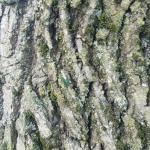
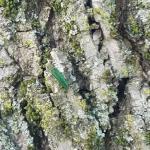
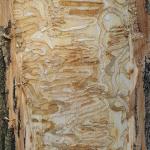 Emerald Ash Borer: (Agrilus planipennis, EAB) As of October 30, 2020, the Massachusetts Department of Conservation and Recreation has confirmed a total of at least 161 communities in Massachusetts that have known populations of emerald ash borer, 62 of which have been found in 2020. An updated map of these locations across the state may be found here:https://ag.umass.edu/fact-sheets/emerald-ash-borer .
Emerald Ash Borer: (Agrilus planipennis, EAB) As of October 30, 2020, the Massachusetts Department of Conservation and Recreation has confirmed a total of at least 161 communities in Massachusetts that have known populations of emerald ash borer, 62 of which have been found in 2020. An updated map of these locations across the state may be found here:https://ag.umass.edu/fact-sheets/emerald-ash-borer .
This wood-boring beetle readily attacks ash (Fraxinus spp.) including white, green, and black ash and has also been found developing in white fringe tree (Chionanthus virginicus) and has been reported in cultivated olive (Olea europaea). Adult insects of this species will not be present at this time of year. Signs of an EAB infested tree may include (at this time) D-shaped exit holes in the bark (from adult emergence in previous years), “blonding” or lighter coloration of the ash bark from woodpecker feeding (chipping away of the bark as they search for larvae beneath), and serpentine galleries visible through splits in the bark, from larval feeding beneath. Positive identification of an EAB-infested tree may not be possible with these signs individually on their own.
For further information about this insect, please visit: https://ag.umass.edu/fact-sheets/emerald-ash-borer . If you believe you have located EAB-infested ash trees, particularly in an area of Massachusetts not identified on the map provided, please report here: http://massnrc.org/pests/pestreports.htm .
- Fall Home-Invading Insects: Various insects, such as ladybugs, boxelder bugs, seedbugs, and stink bugs have already found overwintering shelters in warm places, such as homes, and may continue to do so on warm/mild and sunny days. Many have already invaded our homes or buildings. To deal with any that have found their way indoors, simply vacuum them up – but be sure to empty the vacuum or remove and dispose of the collection bag before returning the vacuum to its storage location.
Concerned that you may have found an invasive insect or suspicious damage caused by one? Need to report a pest sighting? If so, please visit the Massachusetts Introduced Pests Outreach Project: http://massnrc.org/pests/pestreports.htm .
A note about Tick Awareness: deer ticks (Ixodes scapularis), the American dog tick (Dermacentor variabilis), and the lone star tick (Amblyomma americanum) are all found throughout Massachusetts. Each can carry their own complement of diseases. Anyone working in tick habitats (wood-line areas, forested areas, and landscaped areas with ground cover) should check themselves regularly for ticks while practicing preventative measures. Have a tick and need it tested? Visit the web page of the UMass Laboratory of Medical Zoology (https://www.tickreport.com/ ) and click on the blue Order a TickReport button for more information.
Reported by Tawny Simisky, Extension Entomologist, UMass Extension Landscape, Nursery, & Urban Forestry Program
Additional Resources
Pesticide License Exams - The MA Dept. of Agricultural Resources (MDAR) is holding exams for new exam applicants. Space is still limited; to register, go to: https://www.mass.gov/pesticide-examination-and-licensing.
To receive immediate notification when the next Landscape Message update is posted, join our e-mail list or follow us on Facebook and Twitter.
For a complete listing of upcoming events, see our upcoming educational events https://ag.umass.edu/landscape/upcoming-events
For commercial growers of greenhouse crops and flowers - Check out UMass Extension's Greenhouse Update website
For professional turf managers - Check out Turf Management Updates
For home gardeners and garden retailers - Check out our home lawn and garden resources. UMass Extension also has a Twitter feed that provides timely, daily gardening tips, sunrise and sunset times to home gardeners at twitter.com/UMassGardenClip
Diagnostic Services
UMass Soil and Plant Nutrient Testing Laboratory:
Routine soil analysis and particle size analysis ONLY (no other types of soil analyses available at this time):
Turn-around Time Notice for November and December
Lab staff have two weeks of furlough, in addition to holiday breaks, coming up in November and December. Because our staff is so small, our most efficient option is to close the lab for the following periods: November 26 through December 4 and December 14 through January 1. To manage expectations, we are projecting completion dates as follows:
- Samples received in the lab by November 6 should be complete by November 25.
- Samples received in the lab by November 13 should be completed by December 11.
- Samples received in the lab after November 13 will be processed in order of arrival and may be completed by December 11, but most will be completed in January as soon as possible after the staff’s return to a normal work schedule.
Please plan for the fact that date of receipt in the lab is affected by weekends, holidays, shipping time, and time for UMass Campus Mail to deliver samples to the lab. Campus Mail delivery only takes place on Monday, Wednesday, and Friday due to pandemic restrictions.
UMass Laboratory Diagnoses Landscape and Turf Problems - The UMass Extension Plant Diagnostic Lab is available to serve commercial landscape contractors, turf managers, arborists, nurseries and other green industry professionals. It provides woody plant and turf disease analysis, woody plant and turf insect identification, turfgrass identification, weed identification, and offers a report of pest management strategies that are research based, economically sound and environmentally appropriate for the situation. Accurate diagnosis for a turf or landscape problem can often eliminate or reduce the need for pesticide use. For sampling procedures, detailed submission instructions and a list of fees, see Plant Diagnostic Laboratory
Soil and Plant Nutrient Testing - The University of Massachusetts Soil and Plant Nutrient Testing Laboratory is located on the campus of The University of Massachusetts at Amherst. Testing services are available to all. The function of the Soil and Plant Nutrient Testing Laboratory is to provide test results and recommendations that lead to the wise and economical use of soils and soil amendments. For complete information, visit the UMass Soil and Plant Nutrient Testing Laboratory web site. Alternatively, call the lab at (413) 545-2311.
Ticks are active any time that temperatures are above freezing! Remember to take appropriate precautions when working and playing outdoors, and conduct daily tick checks. UMass tests ticks for the presence of Lyme disease and other disease pathogens. Learn more
